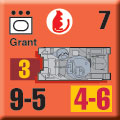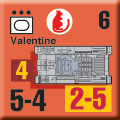| Desert Rat Division:
Organization and Scenarios
By Mike Bennighof, Ph.D.
September 2014
Note: Gold Club members have a last chance to pick up Desert Rat Division by September 15th, 2014: click here to join!
In the late 1930’s, the British garrison command in Egypt added a number of small armored car, tank and motorized units to the Cairo Cavalry Brigade and designed the conglomeration the “Mobile Force.” In September 1938 it became the “Mobile Division,” then the “Armoured Division (Egypt)” and finally in February 1940 the 7th Armoured Division, adopting the nickname “Desert Rats.”
  
At that point, the division had two tank brigades: the Light Tank Brigade and the Heavy Tank brigade. The Light brigade had three “armoured” regiments (as the British Army called its tank and artillery battalions), and the Heavy brigade two, though light tanks and armored cars equipped many squadrons. The rest of the division’s assets - one motorized infantry battalion and some motorized artillery - formed the “Pivot Group.”
By the time war broke out with Italy in June 1940, the division had reorganized. The Light Tank Brigade had become the 4th Armoured Brigade, and the Heavy Tank Brigade the 7th Armoured Brigade. Each now had two armored regiments, and the division command shuffled squadrons between them to make sure each had at least some cruiser tanks. The Support Group now had two motorized infantry battalions. One of the artillery regiments (3rd Royal Horse Artillery) converted to an anti-tank role, with four batteries of 37mm and 2-pounder anti-tank guns, and one of the former armored regiments (11th Hussars) took over the armored cars and became the divisional reconnaissance battalion.
 
That varied from the official tables of organization, which gave each brigade three armored regiments and held the armored car units as corps-level assets. Not following standard organization tables was pretty standard for armored divisions in the North African theater.
By the time the British went on the offensive in the fall of 1940, 7th Armoured Division was up to its full allotment of six armoured regiments, even if some still fielded light tanks. Brigades and battalions would be attached and detached for specific operations, but otherwise the two-brigade structure stayed more or less stable through the spring of 1942, when the British Army finally noticed that its armored divisions needed a greater proportion of infantry (about two years after the Germans caught on to this ratio problem). The 7th Armoured Brigade moved to Burma as an independent unit, replaced by the new 7th Motor Brigade, a motorized infantry outfit with three battalions and supporting arms including artillery. The remaining armored brigade added a motorized infantry battalion of its own plus supporting arms.
Officially, that remained the British armored division organization for the rest of the war. Seventh Armoured Division at times operated with three brigades, two armored and one motorized infantry, with a great deal of attaching, detaching and cross-attaching taking place in North Africa. Seventh Motor Brigade was eventually replaced by the 131st (Queen’s) Infantry Brigade, a motorized unit with three battalions of the Queen’s Royal Regiment. The Desert Rats deployed to Italy in September 1943 with 22nd Armoured Brigade and 131st Infantry Brigade, and kept that organization when they landed in Normandy in 1944 until ending the war in Germany.
During that span, the Desert Rats operated just about every tank built by the United Kingdom and the United States. Massive tank losses in the Western Desert assured constant upgrades; the division only really obtained a standard tank when it returned to England in preparation for the Normandy landings and was issued the Cromwell. All other British armored divisions used the Sherman in their armored regiments; the 1st Polish Armored Division also used the Cromwell. Less reliable than the Sherman, the Cromwell offered somewhat better speed.
Our Desert Rat Division set of special pieces showing the 7th Armoured Division in its own special scarlet color scheme with its distinctive jerboa emblem. The mix of pieces is based on the division’s equipment in late 1941 and early 1942, so the drab British pieces may have to serve in some scenarios taking place before and after that period. Here’s a list of scenarios from Afrika Korps and Desert Rats featuring the 7th Armoured Division, and there are a lot of them:
Afrika Korps
Note: I don’t remember why, but Afrika Korps doesn't follow the usual Panzer Grenadier convention of presenting scenarios in chronological order. It’s the oldest Panzer Grenadier game still in print so that may have something to do with it.
Scenario 12: Tank Battle at Mechili
Scenario 13: Beda Fomm One (Combe Force was drawn from 7th Armoured Division units)
Scenario 14: Beda Fomm Two
Scenario 16: Forte Pilastrino
Scenario 17: Catanzaro Division, Southern Sector
Scenario 18: Catanzaro Division, Eastern Sector (and you really should use the Blackshirt pieces from Fronte Russo in place of the CCNN battalions’ infantry)
Scenario 45: Operation Brevity, Fort Capuzzo
Scenario 46: Operation Brevity, Sidi Azeiz
Scenario 47: Operation Skorpion
Scenario 48: Beda Fomm, Tank Attack
Scenario 49: Babini at the Front
Scenario 50: Fort Capuzzo
Desert Rats
Scenario 3: A Single Day as a Lion (just the tanks)
Scenario 4: A Hundred Years as a Sheep (just the tanks)
Scenario 5: Libyan Defiance (just the tanks)
Scenario 10: Bir el Gubi
Scenario 11 Gabr Saleh
Scenario 12: Sidi Rezegh, First Action
Scenario 13: Advance and Engage
Scenario 14: Bir bu Meliha
Scenario 15: Sidi Rezegh, Counter Attack
Scenario 16: The Panzers Pull Back (officially, 22nd Armoured Brigade was only attached to the division at this point)
Scenario 17: The Tomb of Sidi Rezegh
Scenario 18: A Pibroch’s Skirl
Scenario 19: The Panzers Returns
Scenario 29: The Tide Turns
Scenario 44: Grants’ Tomb
Scenario 45: South of Gazala
Scenario 47: Khamsin
Click here to order Desert Rats (the game)!
Mike Bennighof is president of Avalanche Press and holds a doctorate in history from Emory University. A Fulbright Scholar and award-winning journalist, he has published over 100 books, games and articles on historical subjects.
He lives in Birmingham, Alabama with his wife, three children and his dog, Leopold.
|
